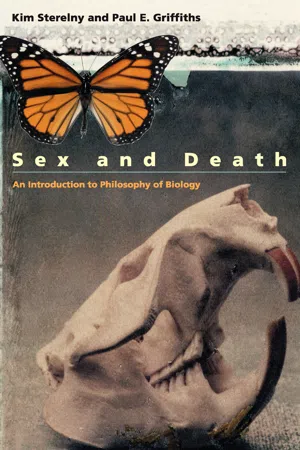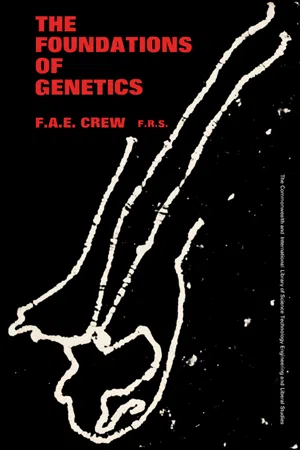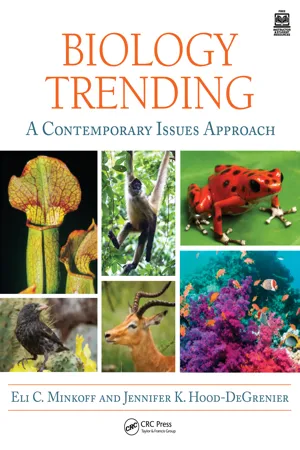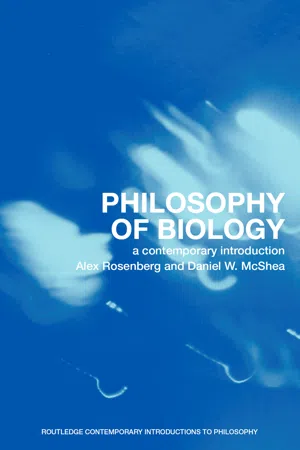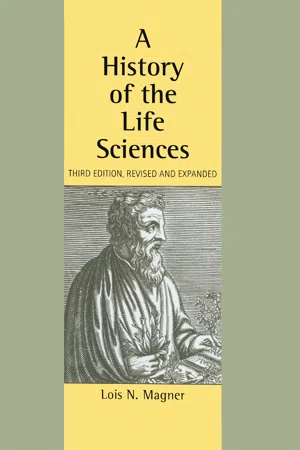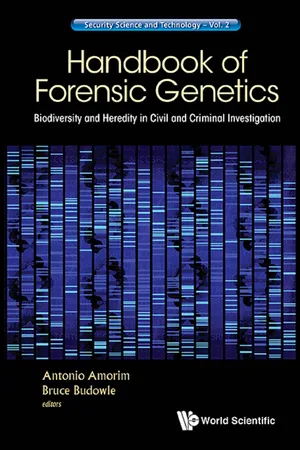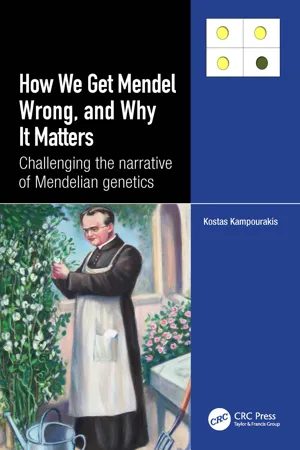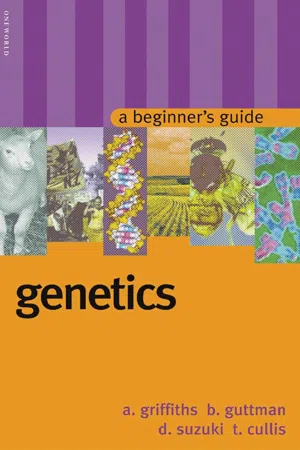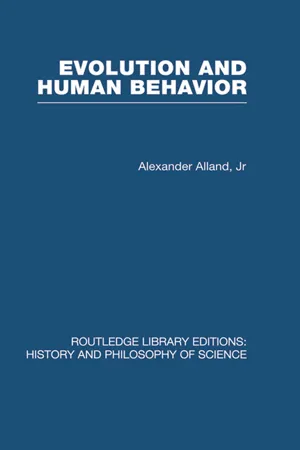Biological Sciences
Mendel's Law of Segregation
Mendel's Law of Segregation states that during the formation of gametes, the two alleles for a gene segregate from each other so that each gamete carries only one allele for each gene. This means that offspring inherit one allele from each parent, leading to genetic diversity in the population.
Written by Perlego with AI-assistance
Related key terms
9 Key excerpts on "Mendel's Law of Segregation"
- eBook - ePub
Sex and Death
An Introduction to Philosophy of Biology
- Kim Sterelny, Paul E. Griffiths(Authors)
- 2012(Publication Date)
- University of Chicago Press(Publisher)
But the two other senses may not: they are compatible with the two theories being integrated without one being incorporated within the other. Consider, for example, the fact that genes are often pleiotropic; that is, they have effects on more than one trait. Explanation by decomposition may be an effective strategy for studying this phenomenon even if the relationship between pleiotropy and the molecular mechanisms that explain it is too complex and varied for there to be a bridge law defining it in molecular terms. We have no interest in haggling over which of these various ideas deserves to be called “reduction.” The important point is to recognize their differences, and the fact that the relationship between real theories in science will rarely fit exactly one of these definitions cleanly. So the reader is warned: in this and the next chapter, a number of balls are in the air. We first sketch the empirical background of this controversy, and then proceed to the theoretical upshot. 6.2 What Is Mendelian Genetics? Mendelian genetics is the theory that grew by elaboration and development of the laws of segregation and independent assortment after these were rediscovered at the beginning of the twentieth century. The first Mendelians realized that the pattern of inheritance of some biological traits could be explained by postulating a pair of factors underlying each trait—a pair of alleles occupying a locus on a chromosome. The law of segregation says that the two alleles are separated in the formation of the gametes (sex cells), with each gamete receiving only one allele. Although the alleles from two gametes are united in the zygote (the fertilized egg), they do not mix together, and they are separated again to form the next generation. The law of independent assortment says that the probability of a gamete receiving a particular allele at one locus is independent of which allele it receives at another locus - eBook - ePub
- F. A. E. Crew, J. M. Dodd, Francis Knowles(Authors)
- 2014(Publication Date)
- Pergamon(Publisher)
CHAPTER 3MENDELISM: THE LAW OF SEGREGATION
Publisher Summary
This chapter discusses the law of segregation. Mendel, who completed what the other horticulturalists and botanists of repute had begun, was able to show conclusively that organic inheritance in the higher, sexually reproducing plants was particulate, the hereditary determinants behaving as units. He showed that when the hybrid offspring of the same parents of pure descent were crossed with one another, it was always possible to reclaim among their progeny individuals that bred true to the parental types. He showed that that when the parents differed in respect of several characters, these were combined in various ways in the second hybrid generation and as some of the individuals displaying each of these combinations were capable of breeding true to type, new combinations of characters could be fixed. He also showed that when the parents differed from each other in respect of a single character, the inter-crossing of the first generation hybrids produced a second hybrid generation in which a constant proportion of the two parental types could confidently be expected.IN BRÜNN in Mendel’s time there was a flourishing scientific society. Among its members, of whom Mendel was one, were several scientists of repute belonging to the different educational institutions in the city. Mendel served for a period as president of this society. At its meetings on 8 February and 8 March 1865 he presented a communication on his experiments in plant hybridization (Versuche über Pflanzen-Hybriden ). This was published in the Proceedings of the Brünn Society for the Study of Natural Science (Verhandlungen des naturforschenden Vereines in Brünn - eBook - ePub
Biology Trending
A Contemporary Issues Approach
- Eli Minkoff, Jennifer K. Hood-DeGrenier(Authors)
- 2023(Publication Date)
- CRC Press(Publisher)
segregation of alleles is often stated as Mendel's first law. (The term “law” was used more frequently in the past; in this case, it simply means a concept devised to explain the data.)During sexual reproduction, the gametes combine so that each F2 individual has two alleles, one contributed by the egg and one by the sperm. This explains both why the recessive phenotype disappears in the F1 and why it reappears in about one-quarter of the F2 individuals.Figure 2.3 shows Mendel's multipart hypothesis applied to one of the traits he studied. A pure-line plant with violet-red flowers and the genotype VV, which produces V gametes, is crossed with a pure-line, white-flowered vv plant, which produces v gametes. All F1 plants, having received V from one parent and v from the other, have violet-red flowers and the heterozygous genotype Vv. Half of the eggs produced by the F1 carry the dominant allele V and half carry the recessive allele v, and the same is true for the sperm, as indicated in the margins of the square in Figure 2.3 . When the gametes from the self-pollinated F1 combine at random to form the F2 generation, one out of every four new individuals is homozygous for the dominant allele VV and has violet-red flowers, two out of four are heterozygous Vv with violet-red flowers, and one out of four is homozygous for the recessive allele vv and has white flowers. The ratio of violet-red to white phenotypes is thus 3:1. A square like this, showing how gametes combine to produce genotypes and phenotypes, is called a Punnett square .Figure 2.3One of Mendel's experiments with peas differing in a single trait.2.1.3.1 Independent assortment
After Mendel had investigated the inheritance of single traits, he proceeded to study the inheritance of two traits together. In one of his experiments, the parents differed in both seed shape and seed color. For these traits, yellow seed color is dominant over green seed color and round seed shape is dominant over wrinkled seed shape. The parents in one group were pure-breeding for yellow, round seeds (YYRR) and thus produced all YR gametes. The other parents were pure-breeding for green, wrinkled seeds (yyrr) and thus produced all yr gametes. The first-generation offspring (F1 ) were all YyRr, heterozygous for both traits. All these F1 - eBook - ePub
Philosophy of Biology
A Contemporary Introduction
- Alex Rosenberg, Daniel W. McShea(Authors)
- 2007(Publication Date)
- Routledge(Publisher)
It does not take much more examination than that to conclude that Mendel’s laws are not, after all, really laws at all. Mendel did his famous experiments on pea plants in the mid-nineteenth century. His published results went unnoticed until rediscovered in the early twentieth century and, since then, a major theme of the history of genetics has been the discovery of more and more exceptions to his laws. Luckily for Mendel and for genetics, the traits he first studied did not happen to involve genes located close together on the same chromosomes. Had they been so “linked,” that is lying close together on the same chromosome, they would not have assorted independently. Once linkage was detected, it became clear that the second law is a rough and ready generalization with enormous numbers of exceptions, such as those arising from linkage. As for the law of segregation, geneticists now know cases in which segregation is unequal, in which one of the two alleles is preferentially transmitted to the next generation, the so-called segregation distorter alleles.Of course, just because Mendel’s principles are not laws does not mean that they are not important in biology. What it does mean is that when they are successfully applied in prediction, and when they are not, is a matter to be explained by appeal to other more fundamental regularities. In the case of Mendel’s laws, these will be regularities about meiosis and other details of cell physiology. Is that where the laws are? Somewhere in these lower level processes, is that where we will find the fundamental causal laws of biology that explain Mendelian generalizations and their exceptions?The answer is almost certainly not. Again, the reason goes back to Darwinian theory. For the theory tells us that meiosis, segregation, and assortment are—like other features of organisms such as genes, chromosomes, and sexual reproduction—the result of a long evolutionary history. In the course of that history, natural selection produced adaptation, including both the Mendelian processes themselves—such as meiosis that produces segregation—and other non-Mendelian processes, some of which—such as segregation distorters—take advantage of Mendelian processes. Future environmental changes could modify meiosis further, or even do away with it altogether. Similarly, if natural selection is operating on other worlds circling other suns, we have some reason to suppose that there will be replicators and perhaps also interactors on these worlds but little reason to suppose that they will reproduce by meiosis, or that anything like Earthly sexual physiology will have emerged. The domain of any laws that we discover about sexual processes, or about anything else in biology, could well be quite limited, that is to say limited to a single instance of biology here on Earth and further limited to a particular time range in Earthly evolutionary history. - Lois N. Magner(Author)
- 2002(Publication Date)
- CRC Press(Publisher)
The dominant trait appears in individuals with two A factors (genotype AA) or one factor A and one factor a (Aa). The recessive trait appears only in individuals with the genotype aa. The law of independent assortment, also known as Mendel’s second law, refers to this demonstration that the behavior of any pair of traits is independent of all other pairs of traits. Even after the rediscovery of Mendel’s work, geneticists did not clearly explicate the second law until they were forced to cope with embarrassing deviations from independent assortment. The results of Mendel’s experiments on peas were discussed in a paper presented at the March 1865 meeting of the Brno Natural History Society and published in the 1866 issue of the Society’s Proceedings, a journal that was distributed to over 100 scientific institutions in Europe and the United States. Mendel thought that his presentation at the Brno Natural History Society had encountered “divided opinion,” but he was pleased to be asked to publish his lecture in the Proceedings of the society. Reflecting on the difficulty of reconciling his results with contemporary scientific knowledge, Mendel reflected on the brevity of exposition that was necessarily imposed on a public lecture. Perhaps the brevity of his presentation accounts for the subsequent confusion and misinterpretation. Some historians claim that Mendel was only interested in the role of hybrids in the generation of new species- eBook - ePub
Handbook Of Forensic Genetics: Biodiversity And Heredity In Civil And Criminal Investigation
Biodiversity and Heredity in Civil and Criminal Investigation
- Antonio Amorim, Bruce Budowle(Authors)
- 2016(Publication Date)
- WSPC (EUROPE)(Publisher)
chromosomes, each one predictably with its own but similar mode of transmission. We are now ready to address Mendel’s work with a new focus and an extended framework. It is somewhat surprising that Mendel solved the more complex mode of transmission, i.e. sexual reproduction. We begin by presenting this work and then generalize it to the primary modes of transmission observed in eukaryotes, using the human example, which is a good model for mammalians, and for obvious forensic genetics applications. Other examples will be dealt in other chapters of this book.Mendelian Theory of Inheritance and Modes of Transmission
First of all, Mendel limited his research to cases where observed differences in a specific characteristic(s) between members of a population were clear-cut, i.e. all members could be classified into discrete groups without ambiguity. It is believed that, when studying seed color in his experimental model (Pisum sativum ), Mendel was not ignorant of the differences existing among ‘yellow’ or ‘green’ peas, but he took advantage of the gap between these characteristics, just classifying them into two phenotypic groups. Phenotype will refer to each of the classes into which members of a population can be grouped according to their appearance for a specific characteristic. Mendel hypothesized that, if the observed differences are of a hereditary nature, there should be some place in the cell where the information for the characteristic should be stored. We now know that location — it is a specific region of DNA called a locus (plural: loci) and specifically for the characteristic a gene. He further thought that some difference in content of that information should be responsible for the observable alternative, that is, in modern parlance, that a locus could contain alternative forms (differences in DNA sequence), called alleles. Mendel reasoned further that, in order to avoid the Russian doll paradox, the number of copies of this information should be reduced in each generation of sexual reproduction, so that both parents should generate gametes (female ovules and male spermatozoa) containing only half of the information which, when fusing to form an egg, would reconstruct the amount present in each progenitor. Therefore, each locus can be present in double copy (diploidy), as in the cells of the body of progenitors and in single copy (haploidy), as in gametes. Another term is genotype, which is the specific genetic state of occupancy of a locus in a cell or individual. If the diploid cell possesses two different alleles at a specific locus, it is said to be heterozygous, and if the alleles are identical the genotype is referred to as homozygous. Lastly, Mendel observed that the discrete trait could disappear in one generation and reappear in the next one. Thus, he deduced that these heritable entities were unchanged as they passed form parent to offspring. We now know this observation to be the result of dominant and recessive - eBook - ePub
How we Get Mendel Wrong, and Why it Matters
Challenging the narrative of Mendelian genetics
- Kostas Kampourakis(Author)
- 2023(Publication Date)
- CRC Press(Publisher)
2 Weldon initially stated Mendel’s two laws, as he perceived them, which he called the laws of “Dominance” and “Segregation”:The first general result obtained by Mendel may be stated as follows: If peas of two races be crossed, the hybrid offspring will exhibit only the dominant characters of the parents; and it will exhibit these without (or almost without) alteration, the recessive characters being altogether absent, or present in so slight a degree that they escape notice.3This may be called the Law of Dominance, and it at once explains the terms “dominant” and “recessive”.The second result is that: If the hybrids of the first generation, produced by crossing two races of peas which differ in certain characters, be allowed to fertilise themselves, all possible combinations of the ancestral race-characters will appear in the second generation with equal frequency, and these combinations will obey the Law of Dominance, so that characters intermediate between those of the ancestral races will not occur.4From its consequences, this may be called the Law of Segregation.In commenting on Mendel’s results, Weldon noted that among 8,023 seeds of the second generation, 6,022 were yellow and 2,001 green, with no seeds of intermediate color occurring. He thus remarked that “The ratio between either of these numbers and the number of seeds observed is an excellent approximation to that required by Mendel’s law of segregation”.5 Weldon then proceeded to consider what one should have found if one considered deviations, due to chance, of the observed results from those expected based on theory. After making the relevant calculations, he concluded that Mendel’s results in terms of the agreement between the expected and the observed frequencies were overall very good. One could then conclude that Mendel’s own results supported his theory. But Weldon concluded, by applying Pearson’s statistical methods, that “the odds against a result as good as this or better are 20 to 1”.6 - eBook - ePub
Genetics
A Beginner's Guide
- Burton Guttman, David Suzuki, Tara Cullis, Anthony Griffiths(Authors)
- 2002(Publication Date)
- Oneworld Publications(Publisher)
What is the probability that you’ve inherited his a allele? Well, the chance that your mother received it from him is ½ and the chance that you received it from her is ½, so the probability is ¼. This is just like flipping a coin twice in a row. The probability is exactly the same that you have received any specific allele from any gene pair in any grandparent. When would two events not be independent? Suppose for some reason that an A egg tends to attract A -bearing sperm and an a egg tends to attract a -bearing sperm. Then in a mating of an Aa male and an Aa female, both producing equal numbers of A and a eggs, the probabilities of getting the various offspring would be skewed from what we usually expect, since fertilization would not occur at random. two or more genes An important application of these concepts of probability is in predicting the results of crosses where we follow two or more genes simultaneously. Mendel performed such experiments, in which he followed characters such as seed color and seed shape together, and they led him to a second important principle, the law of independent assortment : the alleles of two genes assort independently when gametes are being formed. In Chapter 5, we will show how Mendel’s laws follow from the way chromosomes move during cell division. Mendel knew nothing about chromosomes and their behavior in reproduction, and he derived the law of independent assortment strictly from patterns of inheritance, but he was lucky. We shall see later that many genes occur together on the same chromosome and therefore tend to be inherited together, so these are not independent events. However, it just happened that the genes for all the characters that Mendel studied are on different chromosomes (or are so far apart on one chromosome that they are essentially independent) - eBook - ePub
Evolution and Human Behaviour
An Introduction to Darwinian Anthropology
- Alex Alland(Author)
- 2012(Publication Date)
- Routledge(Publisher)
II Mendelian GeneticsPassage contains an image
Probably since the earliest domestication of plants and animals man has used certain genetic principles without fully understanding them. Species were improved by breeding selectively only those animals which carried desirable traits and by disposing of those animals which did not. Thus, even today the life expectancy of a good egg-laying chicken is considerably higher than her less bountiful sisters.To understand how selective breeding actually works, one must understand how and in what frequency specific characteristics pass from parent to offspring. Traits do not always appear to pass in orderly fashion. Two parent animals, each with the same trait, might transfer it to all their progeny while two other parents, again with the same trait, might transfer it with a frequency of only 50 per cent. On the other hand, an entire generation of siblings might differ considerably from either parent. Until the reasons for this variation were understood it was difficult to predict what the outcome of any specific cross might actually be.A set of simple but elegantly controlled experiments conducted by the Abbé Mendel in the 1860s solved this basic problem and opened up the entire field of genetics. Unfortunately Mendel’s work, although published in 1866, was ignored by the scientific community until 1900. The development of genetics, which progressed rapidly after this date, was tremendously important to evolutionists, for it provided a central concept of evolutionary theory: an explanation of the mechanisms of variation and continuity.The science of genetics which Mendel founded is tremendously powerful, for its theories can be tested and verified in the laboratory through the replication of experiments under controlled conditions. Thus, with the development of genetics a laboratory science was added to the natural-historical approach of the early evolutionists.Mendel’s experiments were carried out on the common pea plant. In his search for order in the transmission of genetic material, Mendel chose pea plants displaying seven classes of easily observable traits, each with two variants. Among these were: height (tall vs. short); seed color (green vs. yellow); and seed texture (smooth vs. wrinkled). Mendel was careful to choose plants of pure strain, which when crossed with like plants bred true consistently, i.e. yellow plants produced 100 per cent yellow offspring, short plants produced 100 per cent short offspring, etc. Plants with various combinations of these three classes of traits were then crossed (tall, green, wrinkled, with short, yellow, smooth, for example) to produce a filial or F1 generation. Members of this generation were again crossed to produce still another filial or F2
Learn about this page
Index pages curate the most relevant extracts from our library of academic textbooks. They’ve been created using an in-house natural language model (NLM), each adding context and meaning to key research topics.
